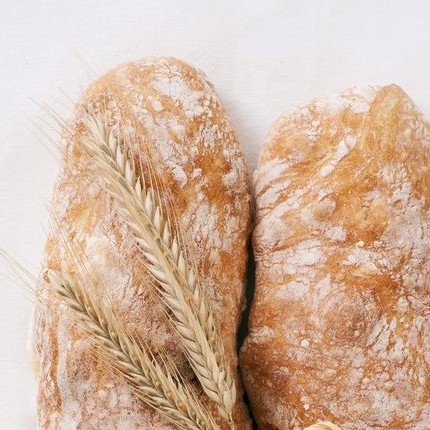
Italian Bread
What is Italian Bread?
Italian bread is a hearth-baked product leavened with commercial baker’s yeast or based on sourdough. It is generally characterized by a hard crust, chewy crumb and unique cell structure (grain).
Examples of Italian breads include:
Origin
Italian breads have traditionally been produced with preferments, such as a biga and sourdough systems. Italian bakers have always been known for their unique baking techniques and passion for the art and craft of breadmaking. Several family generations have consistently used sourdough systems that have been fed for decades, even centuries.
How does it work?
In accordance with Italian baking traditions, only flour from durum wheat (Tritucum durum) is used in true Italian breads. This flour gives a unique texture, flavor, aroma and color on the baked goods and requires special formulation and dough processing.
Durum flour specifications for Italian bread production:
- Protein content: 13.0–16.0%.
- Ash content: 0.5–0.8%.
- Moisture content: 14.0%
- Damaged starch: 7.0–8.0%.
- Values vary according to kernel hardness and milling conditions. Starch damage is desired in long fermentations as substrate for amylases and food for yeast and bacteria.
- Particle size: 125–220 µm (microns).
- Milled from durum wheat with a particle size index (PSI) of 3.0–4.0.
- Water absorption: values can be 10–20% higher (baker’s %) compared to levels seen in common wheat flour (Triticum aestivum).
- Alveograph: P/L ratio < 1.5.
- Given the strength of durum doughs, more extensibility is desired than resistance to deformation.
- Mixing properties: are assessed and optimized according to process needs by using the farinograph.
- Falling Number: 200–250 seconds (sufficient amylase activity to support fermentation and gassing without added sugar).
- Flours of low amylase activity (Falling Number > 350 s) should be supplemented with diastatic malt (malted barley flour).
Application
One example of an Italian bread is the Altamura bread. As its name suggests, it is original from the city of Altamura located in the Italian southeast region of Apulia (Puglia). This bread is the most famous Italian durum wheat bread and the only European bread awarded the “protected designation of origin” (PDO) label.1
Altamura bread is not leavened by any commercial yeast. Instead, it uses sourdough. A portion is taken from a mother sour (a plastic sponge or starter) that has been properly fed and stored. This mother sour contains a unique culture composition of different strains of wild yeasts and lactic acid bacteria (LAB).
Origin-protected Altamura bread only uses ingredients sourced and prepared locally (i.e. within the area of the Provincia di Bari). It only uses four ingredients:
- Durum wheat flour (or re-milled semolina)
- Water,
- Salt
- Sourdough.
| Sourdough refreshment formula | |
| Ingredient | True % |
| Durum flour | 55.0* |
| Water | 27.0** |
| Mother sourb | 18.0a |
*TTA, pH and temperature should be carefully monitored during sourdough fermentation. Levels may change in each bakery.
**Sourdough obtained above is refreshed (fed and remixed) 3 times at intervals of approximately 3 hours.
Processing of sourdough
- Ingredient scaling/metering.
- Mixing: 2–3 min at low speed until homogeneous mixture.
- Sourdough fermentation
- Feeding according to formula above
- Store and use sourdough and mother sour according to production schedule.
| Dough | |
| Ingredient | Baker’s % (based on flour weight) |
| Durum flour | 100.0 |
| Water | 60.0–70.0 |
| Sourdough | 15.0–25.0 |
| Salt | 1.5–2.2 |
Processing of dough
- Ingredient scaling/metering.
- Dough mixing/kneading: mix for 30 seconds on low speed to incorporate sour and the rest of ingredients. Continue mixing on high speed to full gluten development. Artofex mixers (long arm kneaders) can be used to replicate hand mixing.
- Dividing: scaling weight of 1.3 pounds (about 600g). Scaling weight depends on the size of the finished product.
- Dough resting: allow dough to rest on a level surface for about 30–90 minutes at room conditions (cover dough pieces with a thick cloth to avoid skinning).
- Shaping: forming of dough is carried out manually with dusting flour as a processing aid. Typical dough shape is known as “cappello di prete” (priest’s hat).
- Baking: bake in an oak wood-fired oven at 482–536°F (250–280°C) to an internal temperature of 204°F (95°C); baking time of 55–65 min.
- Cooling: Cool loaves to an internal temperature of 90–95°F (32–35°C); cooling time of 1–2 hours.
- Bagging or serving fresh.
Bread processing time from mother sour preparation through cooling is usually 16–18 hours.
References
- Abecassis, J., and Boggini, G. “Other Traditional Durum-Derived Products.” Durum Wheat Chemistry and Technology, 2nd edition, AACC International, Inc., 2012, pp. 177–195.
- Pagani, M.A., Lucisano, M., and Mariotti, M. “Italian Bakery Products.” Bakery Products Science and Technology, 2nd edition, John Wiley & Sons, Ltd, 2014, pp. 686–718.

